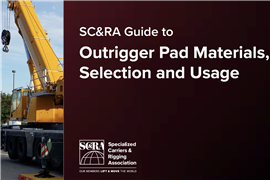Historical move
15 April 2008

King Ramses II died in 1225 BC. During his 67-year rule, Egypt experienced an unprecedented period of economical and cultural prosperity. In 1882 his statue was found and broken up into six pieces. It took until 1954 before the granite structure was relocated to the city centre of Cairo. There, at Ramses Square, it was restored and put on a concrete pedestal to become one of the most well known landmarks in the Egyptian capital.
During its 50 year stay heavy traffic and pollution affected the structure, so the decision was made by government ministers to move the structure to the Grand Egyptian Museum.
To allow the fragile structure to be moved, a series of investigations were carried out by Arab Contractors Company and heavy transport company NOSCO. The thorough and detailed studies revealed that the condition of the 83 tonne statue required moving the structure in its current and upright, 11.35 m high, position. Further detailed investigations in to the method of transport were conducted. To protect the structure from breakage, a steel frame was constructed around and underneath to create a basket. To prevent overstressing the statue, the basket would be allowed to move freely both in the X- and Y-axis. A wire saw was to be used to minimise vibrations during cutting of the base at about one metre from the bottom.
Following the studies three tests were conducted before the move. The first test focused on the route and involved a trial run using one set of eight lines of Scheuerle heavy duty hydraulic modular trailers loaded with 95 tonnes of ballast. Critical spots along the route were tested, including measuring deflection of the El-Mounib Bridge and reaction of the asphalt.
The second series of tests focused on the work procedures and the preparation of the crew. Included was construction of a full scale replica of the statue, erecting the transport frame and loading it on the trailers.
The third and last test consisted of a complete dry run of the move of the replica statue. The test focused on measuring the verticality of the statue and the vibrations during transport. In addition, the manoeuvrability and capacity of the transport configuration was tested.
For real
Following the successful preparations and tests the real statue of Ramses II could be moved. Preparations were made to assemble the steel frame around the statue and to install a set of girder beams with supports that would carry the encaged structure. The beams allowed the statue to hang free and stay as low as possible to keep the centre of gravity low and have maximum stability.
Egyptian heavy transport specialists NOSCO configured two sets of eight lines of Scheuerle heavy duty hydraulic platform trailers. A standard 3 m wide and eight-wheels-per-line trailer carried the front while a 1.5-file and 4.5 m wide, 12-wheels-per-line trailer was positioned at the rear. Turntables on both trailers provided maximum manoeuvrability for the 32.4 m long trailer configuration.
The transport operation turned out to be a festivity attracting tens of thousands of Cairo citizens to watch the Friday night move. It took the NOSCO crew about 10 hours to cover the 35 km long journey from the city centre to the Valley of the Kings. Early the following morning the precious and historic load was delivered at the Grand Egyptian Museum. After finalising the new museum, Ramses II will be the centre of attraction.


